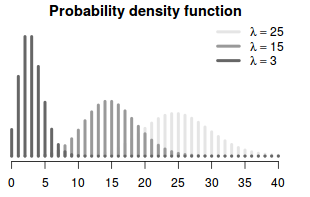Poisson distribution¶
Describes number (count) of independent discrete items or events recorder for a given effort. It is bounded \((0,\infty)\)
\(\lambda\) is the expected value

Properties¶
mean and variance are equal to \(\lambda\)
Connections between Poisson and Binomial¶
Pois -> Bin If we have two random variables $\( X \sim Pois(\lambda_1) \\ Y \sim Pois(\lambda_2) \)$
Where X is independent of Y, than $\(X + Y \sim Pois(\lambda_1 + \lambda_2)\)$
Now if we going to condition \(X | X+Y\) then
Bin -> Pois Now if we have a Binomial random variable $\(Bin(n,p)\)$ Where
\(n \rightarrow \infty\)
\(p \rightarrow 0\)
Than we can approximate the binomial distribution with a poisson distribution \(\lambda = np\) $\( Bin(n,p) \approx Pois(np)\)$
Relationship to Gamma distribution¶
There is a deep relationship between Gamma and Poisson distribution. The Poisson process explains the number of successes during time \(t\), where the rate of successes is \(\lambda\). Gamma distribution on other hand, tells us about the total waiting time till the ath arrival in a Poisson process with rate \(\lambda\).
Conjugacy¶
The gamma distribution can be used as a prior distribution for the rate parameter \(\lambda\) in a Poisson distribution.
\(\bar{y} = \frac{1}{n}\sum_{i=1}^n y_i\)
Sum of two Poisson distribution¶
Given we have random variables that follow poisson distribution:
If X and Y are independent than we have:
